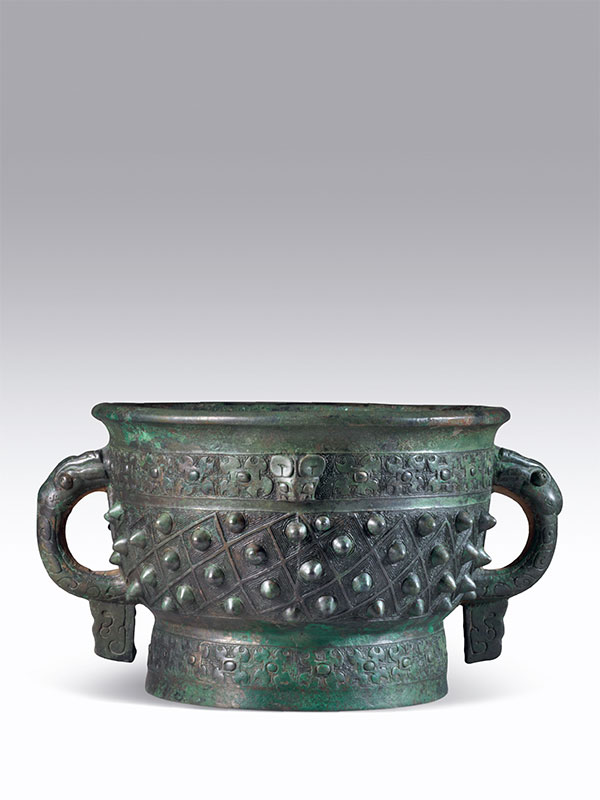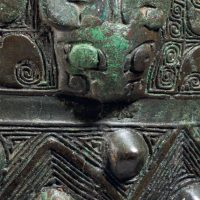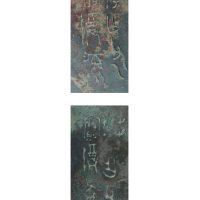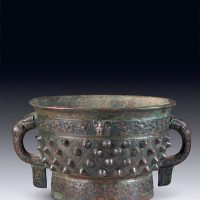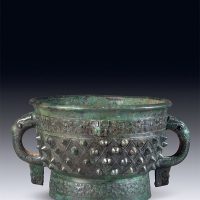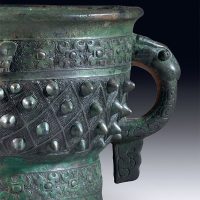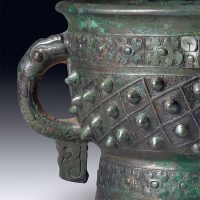Pair of bronze ritual food vessels (Gui) “E Fu Yi”
China, early Western Zhou period, 11th century B.C.
A pair of bronze food vessels (Gui) shape, each supported on a tall, tapered foot. The body is cast with two C-shaped handles which issue from horned, ram-like animal masks just below the flared rim.The handles have rectangular pendants at the bottom and are embellished with engraved flange-patterns.The decoration of the main body consists of a wide band which incorporates four rows of spiky studs, each centred on a diamond pattern. Above this is a narrower band of repeated ‘star’ pattern, which consists of a rounded pupil in a square eye, tipped with a crescent at each corner, all on a ground of leiwen pattern. To the centre of this band, on either side of the vessel is a taotie mask in high relief. Another band of ‘star’ pattern encircles the foot. Inside each vessel is a boldly written inscription in six characters. The patina of both vessels incorporates both green and red areas.
It is very rare to find a virtually identical pair of bronze vessels from this early period. Although the measurements and patina of both vessels vary slightly, it obvious that they belong together. A similar Gui is in the Seattle Art Museum[1]. Earlier versions of this type of Gui are in the Musée Cernuschi, Paris[2] and in the Shanghai Museum[3] The dedicatory inscriptions on both vessels are virtually identical. They can be read as 轭阳作父乙宝尊彝 (Yang Zuo Fu Yi Bao Zun Yi) 轭 means horse collar and refers to the tribe which the donor of this pieces came from. During the Shang dynasty tribes were often identified by the items they excelled in making. In this context, it is evident that the donor came from a tribe known for their expertise in producing horse collars. The Shang dynasty, marked by its warlike nature and thriving commerce, heavily relied on carriages for its development, making horse collars indispensable. This underscores the paramount importance of the tribe back then. The character “阳” represents the donor’s name, while “作” signifies the act of donation. The character “父” has a dual meaning in Chinese academia, referring either to a monarch or a father. Similarly, “乙” can represent the name of a Shang monarch, 小乙 (Xiao Yi), or signify ‘second’, denoting the second rank in ancient Chinese ancestor worship. Additionally, “宝” symbolizes preciousness, and “.尊彝” refers to ritual bronze vessels, reflecting the cultural and artistic richness of the Shang dynasty. In summary, the meaning of these inscriptions is that a man named yang, who came from a wealthy tribe excelling in making horse collars, donated these precious bronze vessels to commemorate his father or the Shang monarch 小乙 (Xiao Yi).
Provenance:
Ben Janssens Oriental Art, March 2000
Private Collection, UK
- Knight, M. Early Chinese Metalwork in the Collection of the Seattle Art Museum, Seattle Art Museum, 1989, no. 9.
- Eliseeff,V. Bronzes Archaiques Chinois au Musée Cernuschi, 1977, no. 11, pp. 32-3, which is dated to the late Shang period.
- Lefebvre d’Argence, R.Y. Treasures from the Shanghai Museum – 6,000 Years of Chinese Art, no. 18.

